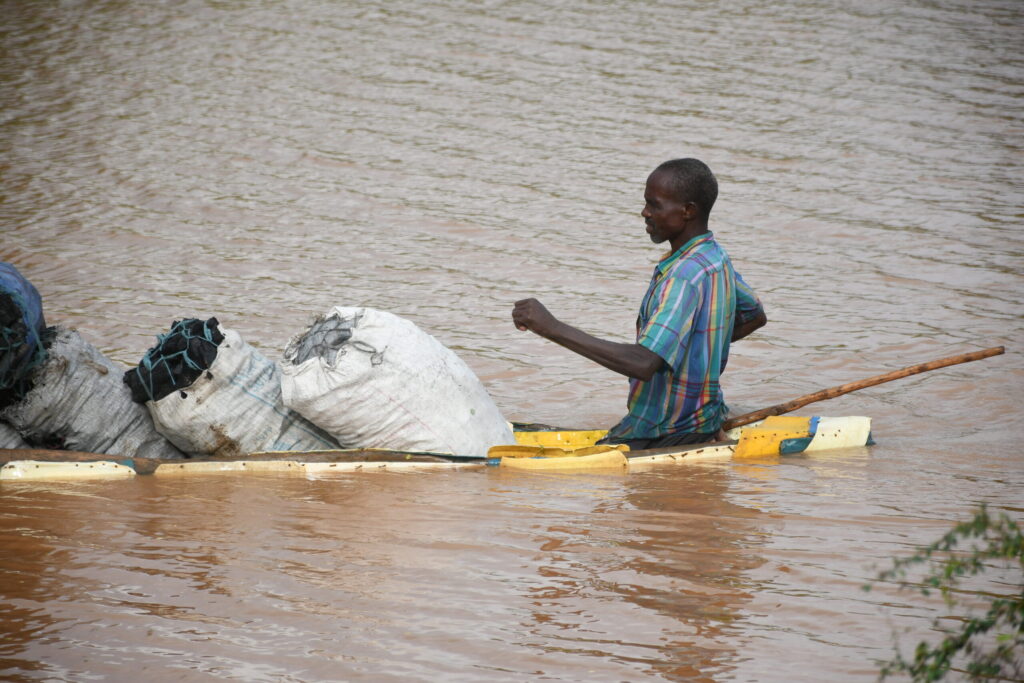
This photo was taken at Garsen in Tana- Delta, Kenya during floods resulting from unusually heavy rains. Usually the charcoal is transported by motor bike or bicycles. Because of the floods, the only means of transport is with makeshift canoes. PHOTO: Rev. Titus Bere.
By Vincent Ondieki–
The World Meteorological Organization reports that increasing temperatures and sea levels, changing precipitation patterns, and more extreme weather are threatening human health and safety, food and water security, and socio-economic development in the Horn of Africa. They further note that climate variability and climate change are major obstacles to resilience in the Horn of Africa, where increasing temperatures and shifting rainfall patterns are already affecting economic growth, livelihoods, food security, health, and ecosystems.
Due to El Nino, devastating flash floods have killed at least 111 people, including 16 children, across the Horn of Africa in recent weeks. More than three-quarters of a million people have been displaced and the rains show no sign of slowing. In Kenya’s northern counties and capital, Nairobi, unrelenting rainfall has led to widespread flooding. An estimated 80,000 people have been displaced or marooned in this area alone, and a further 46 have died since the beginning of the rainy season in September. Fatalities and missing persons are being reported on an almost daily basis.
Save the Children reports that heavy rainfall in Somalia and the Ethiopian highlands has left the central Somalia town of Beledweyne completely submerged. The Shabelle River burst its banks, forcing about a quarter of a million people, a full 90 percent of the population, from their homes. Across Somalia, eight children were amongst 32 people who are known to have died in the floods, with close to half a million displaced across the country. In Ethiopia, at least 33 people, including eight children, have died in the floods. Most drowned while trying to flee the devastation caused by the ongoing rains.
Ironically, the El Nino rains come on the heels of the worst drought in this part of Africa in 40 years, a drought which itself followed five failed rainy seasons. The droughts and lack of rain had already decimated livestock and crops, pushing the region to the brink of famine. These weather events so cruelly following each other illustrate the extreme and irreversible impacts of climate change on already vulnerable communities in the Horn of Africa and the resulting losses and damages that vulnerable communities suffer.
Thankfully, at COP27 parties agreed to establish a funding arrangement for losses and damages such as these. The commitment to a Loss and Damage Fund represents a renewed commitment to supporting local, rural, and vulnerable communities most affected by the climate crisis.
At both the first Africa Climate Summit and the Africa Climate Week this past September there was a resounding call for the operationalization of the Loss & Damage Fund – including setting up a board to guide its directions. The COP28 transition committee has developed proposals for the fund on governance structure, replenishment, and accessibility.
What happens in and beyond COP28 in Dubai must make loss and damage funds accessible to vulnerable communities. This is critical for climate justice and rebuilding trust, so that communities and nations can rebuild sustainably. If not, options exist to double commitments to finance adaptation to avoid occurrences of losses and damages. This is my wish for COP28.
Vincent Ondieki is an Environmental Governance and Climate change specialist who has worked nationally (in Kenya) and continentally (in Africa). He recently started working with ACT Alliance on climate justice issues in Africa.
Source: https://actalliance.org/
